- 1Department of Animal Science, College of Agriculture and Natural Resource Sciences, Debre Berhan University, Debre Berhan, Ethiopia
- 2School of Animal and Range Sciences, Hawassa University, Hawassa, Ethiopia
- 3School of Smart Agriculture, Adamas University, Kolkata, India
This study was conducted at the Sheep and Goat Crossbreeding and Multiplication Center of Hawassa University, Ethiopia, to evaluate milk production, composition, and udder morphology in Boer goats and their crosses. The relationships between these traits and their predictive potential for milk yield across lactation stage were analyzed. The study involved fourteen multiparous goats (seven Boer and seven crossbred) which were monitored over a 14-week of lactation period. Milk yield was measured weekly using the weigh-suckle-weigh method, while milk composition was determined biweekly using a standard laboratory procedure, and udder morphometric traits were measured biweekly using a measuring tape and an angle ruler. Data were analyzed using SPSS software (version 20), applied repeated generalized linear models (GLM), Pearson correlations, and stepwise regression. Results showed that Boer goats produced significantly higher milk yields (1.22 ± 0.05 kg/day) compared to crossbred goats (1.01 ± 0.04 kg/day), with both breeds reaching peak production in the third week of lactation. Boer goats also exhibited milk with higher total solids (15.19%), fat (4.64%), protein (4.06%), and solid not fat (10.61%) contents (p < 0.05). A significant negative correlation (r = -0.42) was observed between milk yield and fat percentage. Boer goats exhibited better udder morphometric traits compared to crossbred goats. A strong and positive association between udder and teat circumference and milk yield was noted throughout the lactation period. Regression analysis identified these traits as the strongest predictors of milk yield, explaining 72.8% of the variation in Boer goats and 69.1% in crossbred goats. The findings of this study contribute to ongoing breed characterization efforts in the country and also highlight the possibility of using udder morphometric traits to estimate milk production, replacing the weigh-suckle-weigh method, which is cumbersome and difficult to apply to a larger population.
1 Introduction
Goats play a vital role in the livelihoods of smallholder farmers in developing countries, providing both meat and milk for household consumption and income generation (Tade and Melesse, 2023). Goat milk is particularly valued for its better digestibility, buffering capacity, and therapeutic properties, making it an attractive option for populations with dietary sensitivities or those requiring specialized nutrition (ALKaisy et al., 2023; Navamniraj et al., 2023). Ethiopia has one of the largest goat populations in Africa, with approximately 52.5 million (CSA, 2021). However, the productivity of indigenous goat breeds remains low, particularly in terms of milk production. Consequently, milk yield from indigenous goat breeds is underutilized, as most production efforts are focused on meat rather than dairy (Tegegne and Feye, 2020; Leggesse et al., 2023).
Efforts to improve goat production in Ethiopia have focused on crossbreeding programs to enhance the productivity of indigenous breeds (Habtegiorgis et al., 2024). The Boer goat, a South Africa breed, is widely recognized for its better meat production (Lu, 2001). It also exhibits significant potential for milk production, producing more milk than any other indigenous South African goats (Idamokoro et al., 2017). Studies have reported that Boer goat can produce an average daily milk yield of approximately 3.1 liters under intensive feeding regimes and 0.8 liters under extensive grazing systems (Idamokoro et al., 2017; AE, 2022). Through the Ethiopian Sheep and Goat Productivity Improvement Program (ESGPIP) and collaboration with public institutions, Boer goats have been introduced to improve the genetic quality of indigenous goat populations (Kuraz Abebe, 2022; Tesema et al., 2022).
The Arsi-Bale goat, an indigenous Ethiopian breed, is well known for its adaptability to harsh tropical environments and its multipurpose utility, including meat, milk, and skin production (Tadesse Asfaw, 2018). Arsi-Bale goats exhibit moderate milk production, with reported daily milk yields averaging approximately 208.72 grams (Bedhane et al., 2012). Milk production is an important trait to investigate, as it demonstrates the maternal ability of the dam breed, especially in breeds known for their larger litter sizes, such as Boer. Crossbreeding Boer goats with indigenous breeds, such as the Arsi-Bale, offers the potential to improve meat and milk production while maintaining adaptation to indigenous environmental conditions (Tesema et al., 2022; Habtegiorgis et al., 2024).
Milk composition is a key determinant of its nutritional value and processing characteristics, with parameters like fat, protein, and lactose varying by genotype, lactation stage, and environmental conditions (Barlowska et al., 2020; Tafes, 2020; Akshit et al., 2024). Furthermore, udder morphometric traits, including udder circumference, teat length, and teat angle, directly influence milk yield and milking efficiency (Iniguez et al., 2009). Larger, well-formed udders are typically associated with higher milk yields (Devani, 2021; Udeh, 2021; Zannou et al., 2024). Understanding the relationship between milk production and udder morphometric traits is essential for screening populations for potential milk production based on these phenotypic characteristics, provided a strong relationship is established.
Despite the significance of these traits, there remains a significant knowledge gap regarding the milk production potential and udder morphology of Boer and crossbred goats under Ethiopian conditions. Most previous studies have largely focused on the reproductive performance or meat yield of these goats (Elmaz et al., 2018; Mustefa et al., 2019), leaving critical information about milk composition and udder traits unexplored. This study aims to evaluate the milk yield, milk composition, and udder morphology of Boer and crossbred goats to examine the associations between these variables.
2 Materials and methods
2.1 Study area
The study was conducted at the Sheep and Goat Crossbreeding and Multiplication Center of Hawassa University, Ethiopia. The site is located at an altitude of 1,650 meters above sea level, with coordinates 38°29’E and 7°05’N, approximately 275 km south of Addis Ababa. The region has a subtropical climate, with an average annual temperature of 19°C and annual rainfall ranging from 900–1,200 mm.
2.2 Animals and management
The experiment involved fourteen multiparous goats, seven Boer, and seven 50% crossbred (Boer × Arsi-Bale) goats. Goats in both breeds that gave birth to a single kid within a one-week window period and maintained similar lactation numbers were used. These selection criteria resulted in a reduced number of experimental animals. The goats were managed under a semi-intensive grazing system, which included six hours of daily grazing. Supplementation was provided in the form of 300 grams of concentrate feed per goat per day. The concentrate feed consisted of corn, linseed cake, and wheat bran. Fresh water was provided ad libitum. The does were housed with their kids, except on testing days, ensuring accurate milk yield measurements.
2.3 Milk yield measurement
Milk yield measurement began on the seventh day postpartum to ensure adequate colostrum consumption. The weigh-suckle-weigh method was employed, combining natural suckling and hand milking to remove residual milk. The procedure involved weighing each kid before and after suckling one half of the udder, and the remaining milk from suckled and other half of the udder was hand milked and measured using a graduated cylinder. The difference in kid’s pre- and post-suckling weight was recorded as the amount of milk consumed. Daily milk yield was calculated by doubling the total milk obtained from both the suckling and hand milking. This method is widely used for evaluating the milk production potential of sheep and goats and is reported to provide reasonably accurate estimates of daily milk yield (Mestawet et al., 2012).
2.4 Milk sampling and analysis
Milk samples were collected biweekly throughout the lactation period from each doe. Prior to sampling, the goats’ udders were cleaned with warm water and the teats were disinfected after foremilk discharged. Samples were collected into sterile plastic flasks, immediately stored in ice box at ≤ 5°C, and transported to the Dairy Laboratory at Hawassa University’s College of Agriculture for analysis. Standard methods of milk physicochemical analysis were applied, following the Association of Official Analytical Chemists (AOAC) guidelines (AOAC, 2005). Protein content was determined using the Kjeldahl method, fat content via the Gerber method, total solids by oven-drying method, ash content by muffle furnace ignition, and solid not fat content determined by subtracting fat from total solids. All measurements were performed in triplicate to ensure precision.
2.5 Udder morphometric traits
Udder measurements were taken biweekly before milking using a flexible measuring tape for linear dimensions and an angle ruler for teat angles. Figure 1 shows the following parameters that were measured: Udder length was measured as the distance from the base of the udder attachment to the midpoint of the bottom of the udder, udder circumference was measured at the midpoint of the udder, and udder width was measured at the widest part of the udder. Teat angle was measured in degrees relative to the vertical line from the intramammary ligament using angle ruler. Teat circumference was measured at the midpoint of each teat, teat length was measured distance from the base of the teat attachment to the tip, and teat diameter was measured at the mid-point of the teats. These measurements followed the protocol described by Marie-Etancelin et al. (2005))and Iniguez et al (Iniguez et al., 2009).
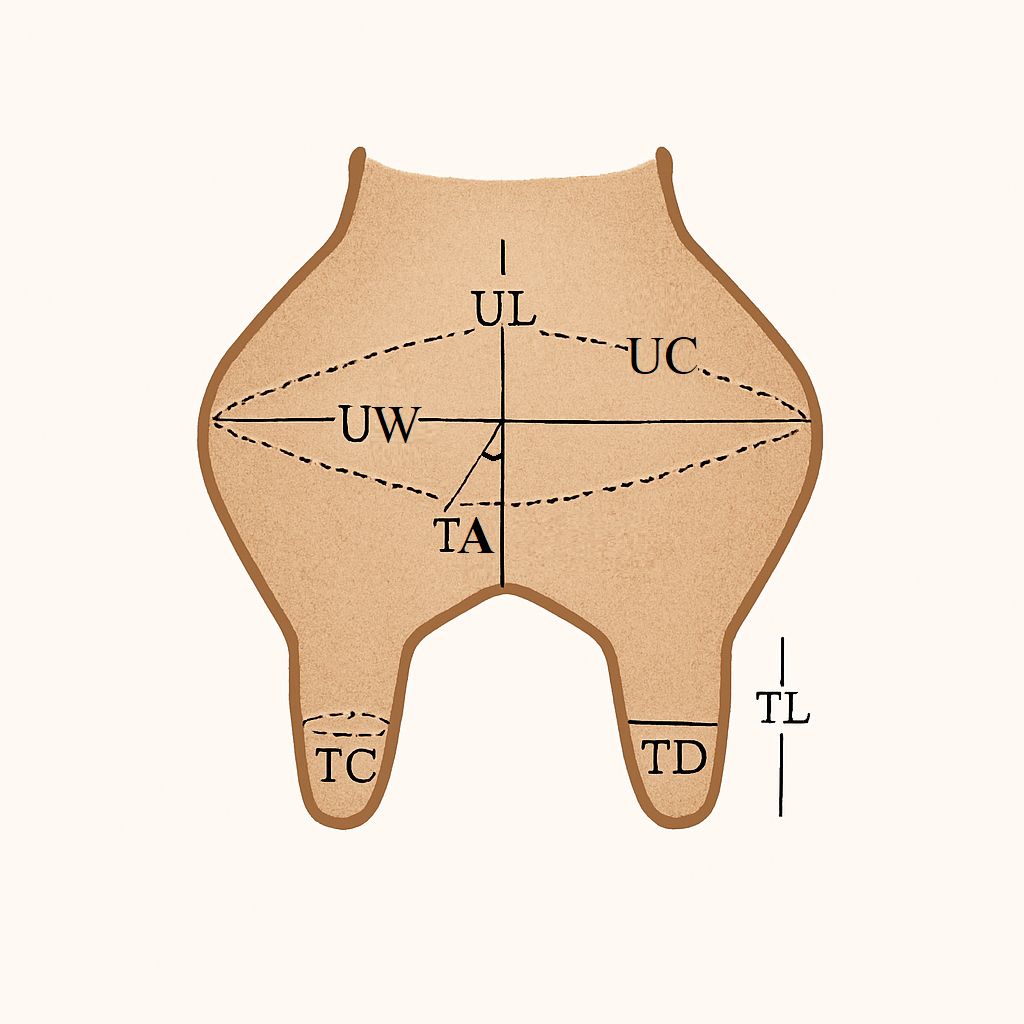
Figure 1. Udder morphometric traits and their measurement positions in goats: udder length (UL), udder circumference (UC), udder width (UW), teat angle (TA), teat circumference (TC), teat length (TL) and teat diameter (TD). Based on James et al. (2009).
2.6 Statistical analysis
Data were analyzed using SPSS software (version 20). A repeated-measures generalized linear model (GLM) was applied to assess the effects of breed, lactation stage, and their interaction on milk yield, milk composition, and udder morphometric traits. Breed and lactation stage were included as fixed effects, while individual animals nested within breed were treated as random effects. Pearson correlation was computed to assess relationships between milk yield and composition, and udder morphological traits. Multiple linear regression was used to predict milk yield based on udder morphological traits. Variance inflation factors (VIF) were calculated to check multicollinearity, with values below 10 considered to ensure acceptable. Tukey’s test was applied for post-hoc comparisons at a significance level of p < 0.05.
The GLM model used:
Where: -
Yijkl = represents the dependent variables (milk yield, total solids, fat, protein, solid not fat, ash, udder circumference, udder length, udder width, teat angle, teat circumference, teat length, and teat diameter),
μ = the overall mean;
Bi = the fixed effect of Breed (Boer goats and crossbred goats);
Ej = the random effect of the doe j within Breed i;
Lk = the fixed effect of lactation stage (week 1, week 2…week 14 for milk yield, week 2, week 4…week14 for milk composition and udder morphometric traits);
eijkl = the residual error.
The multiple linear regression model used:
Where: -
Y = the predicted milk yield;
β0 = the intercept;
β1, …, β7 = the coefficients for the udder morphometric traits;
X1=…, X7 = udder length, udder circumference, udder width, teat angle, teat circumference, teat length and teat diameter;
ε = random residual error.
3 Results
3.1 Breed effects on milk yield and composition
The least-squares means for milk yield and composition traits for Boer and crossbred goats are summarized in Table 1. Boer goats exhibited significantly (p < 0.05) higher milk yield compared to the crossbred goats. The average daily milk yield was 1.22 ± 0.05 kg/day for Boer goats and 1.01 ± 0.05 kg/day for crossbred goats. The milk composition varied significantly between the two breeds (p < 0.05). Boer goats produced milk with higher total solids (15.19 ± 0.83%), fat (4.64 ± 0.08%), protein (4.06 ± 0.12%), and solid not fat (10.61 ± 0.85%) compared to crossbred goats.
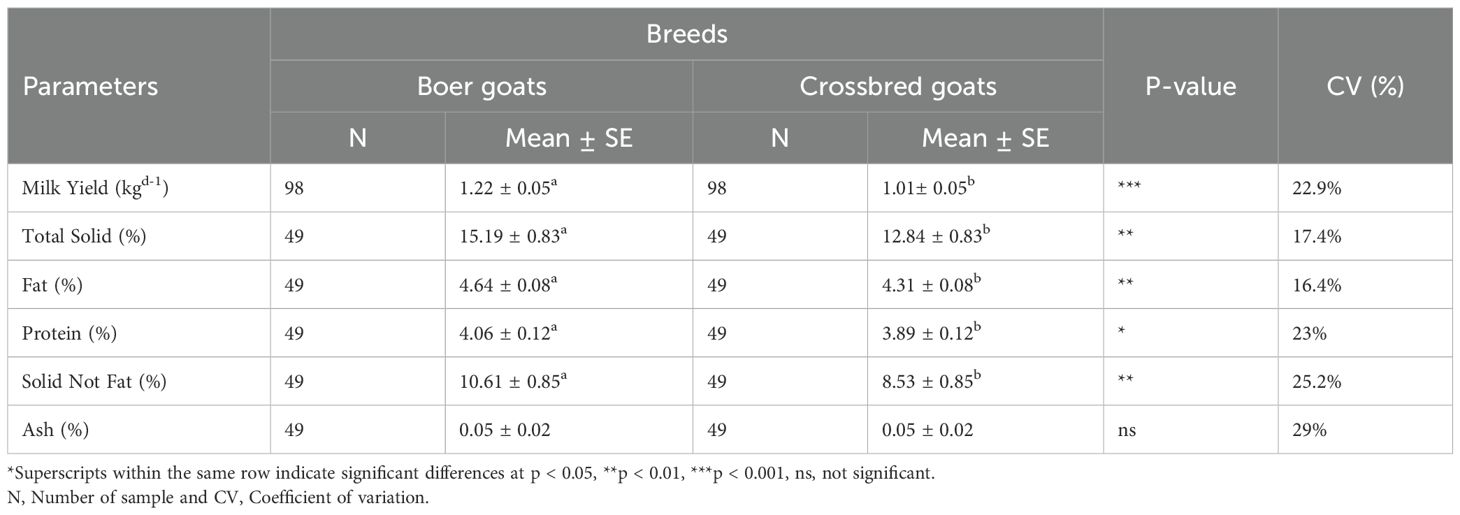
Table 1. Mean (µ) ± standard error (SE) for milk yield (kg/day), total solid (%), fat (%), protein (%), solid not fat (%) and ash (%) in Boer goats and their crosses at the Sheep and Goat Farm of Hawassa University, Ethiopia.
3.2 Breed effect on udder morphometric traits
The least-squares means for udder morphological traits for Boer and crossbred goats are summarized in Table 2. Boer goats exhibited significantly (p < 0.05) longer udder lengths (12.69 ± 0.22 cm), wider udder widths (13.31 ± 0.16 cm), larger teat circumference 6.39 ± 0.19, and greater teat angle (57.76 ± 1.41°) compared to crossbred goats (p < 0.05).
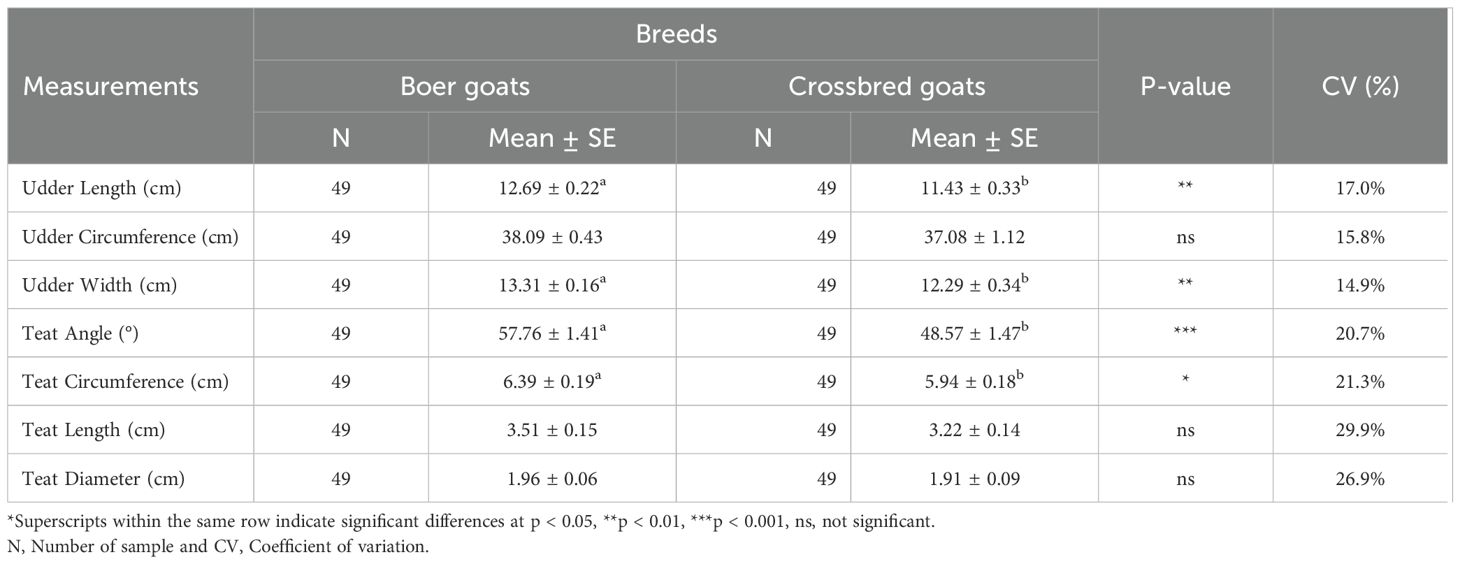
Table 2. Mean (µ) ± standard error (SE) for udder length (cm), udder circumference (cm) udder width (cm), teat angle (°), teat circumference (cm), teat length (cm) and teat diameter (cm) in Boer goats and their crosses at the Sheep and Goat Farm of Hawassa University, Ethiopia.
3.3 Effect of lactation stage on milk yield and composition
The lactation stage was significantly influenced milk yield (p < 0.05) in both breeds (Figure 2). Peak milk production was observed during the third week of lactation for both breeds, after which yield gradually declined until the end of lactation. The decline was more pronounced in crossbred goats, suggesting a shorter lactation persistency compared to Boer goats.

Figure 2. Average milk yield (kg/day) in Boer goats and their crosses across the lactation period at the Sheep and Goat Farm of Hawassa University, Ethiopia.
Fat and protein percentage were significantly (p < 0.05) influenced by lactation stage in both breeds (Figure 3). Fat and protein content were lowest at lactation in week 4 and gradually increased as lactation progressed, with the highest values observed at week 14. For Boer goats, the highest fat percentage (5.08%) was recorded in week 14, while the lowest (3.76%) occurred in week 4. Crossbred goats followed a similar trend, with fat percentages ranging from (4.87%) at week 14 to (3.37%) at week 4. Boer goat milk maintained consistently higher fat and total solids content than crossbred goat milk throughout the lactation period.
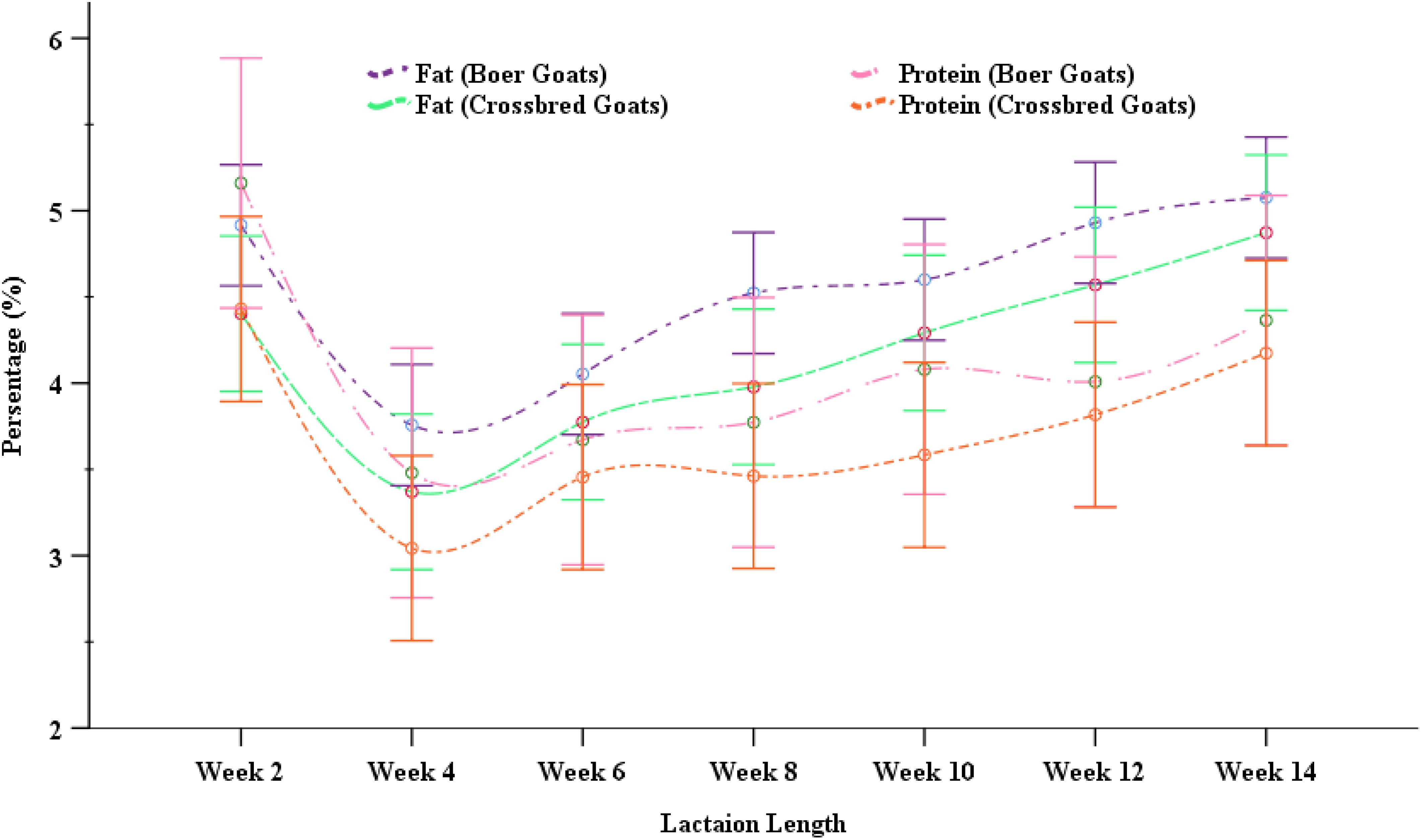
Figure 3. Trends in fat (%) and protein (%) across the lactation period in Boer goats and their crosses at the Sheep and Goat Farm of Hawassa University, Ethiopia.
The trends of milk total solids and solid not fat percentage in Boer and crossbred goats during the lactation stages are depicted in Figure 4. Total solids and solid not fat content exhibited significant variations across the lactation period. Both breeds exhibited a sharp drop in total solids from the second week to the fourth week of lactation, followed by a gradual increase for the remainder of the lactation period. Peak total solid percentages in Boer and crossbred goats were observed in week two (20.04 ± 1.30% and 17.69 ± 1.27%, respectively), while the lowest levels were recorded in week four. The percentage of total solid dropped by 60.2 percent in Boer goats from the second (20.04 ± 1.30%) to the fourth week (12.07 ± 1.30%) and by 52.4 percent in crossbred goats from the second (17.69 ± 1.27%) to the fourth week (9.27 ± 1.27%) of the lactation period, but both breeds slowly increased the total solid percentage for the rest of the lactation period after the fourth week. In the fourth week of lactation, the Boer goats’ and the crossbred goats’ milk exhibited peak solid not fat percentages of 15.12% and 13.29%, respectively. The lowest mean percentage of solid not fat for both the Boer goats 8.02% and the crossbred goats 5.3% was observed at week four. The percentage of solid not fat in milk varied throughout the lactation period.
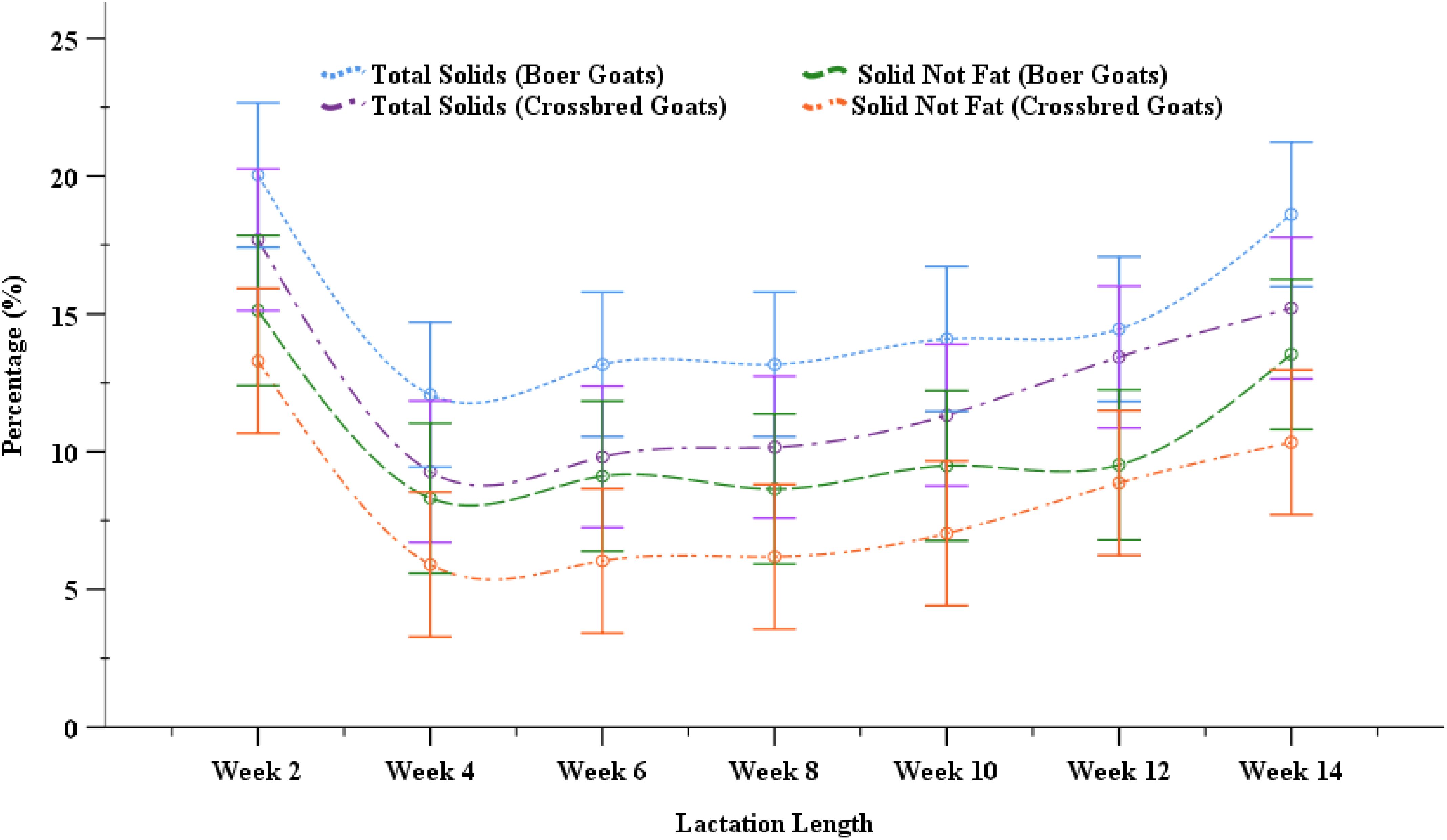
Figure 4. Trends in total solids (%) and solid not fat (%) across the lactation period in Boer goats and their crosses at the Sheep and Goat Farm of Hawassa University, Ethiopia.
3.4 Effect of stage of lactation on udder morphometric traits
The effect of the lactation stage on udder length and width in Boer and crossbred goats are given in Figure 5. Udder length and width were influenced by lactation stage (p < 0.05). The udder length in both Boer and crossbred goats increased until week 6 of lactation and then gradually decreases in Boer goats, while rapidly decreasing in crossbred goats over time. Boer goats had significantly longer udder lengths than crossbred goats after the sixth week of lactation. The maximum udder length recorded was 13.29 cm for Boer goats, while crossbred goats reached 13.57 cm in the same period. The difference in udder length between the two breeds become more pronounced as lactation progresses. Udder width follows a similar trend, with peaks at week 4 for both Boer and crossbred goats. Boer goats displayed a narrower udder (13.71 cm) compared to crossbred goats (15.29 cm) at the peak of lactation. The gradual reduction in udder width after week 4 in Boer goats while a rapid decrease in crossbred goats throughout the lactation period progresses.
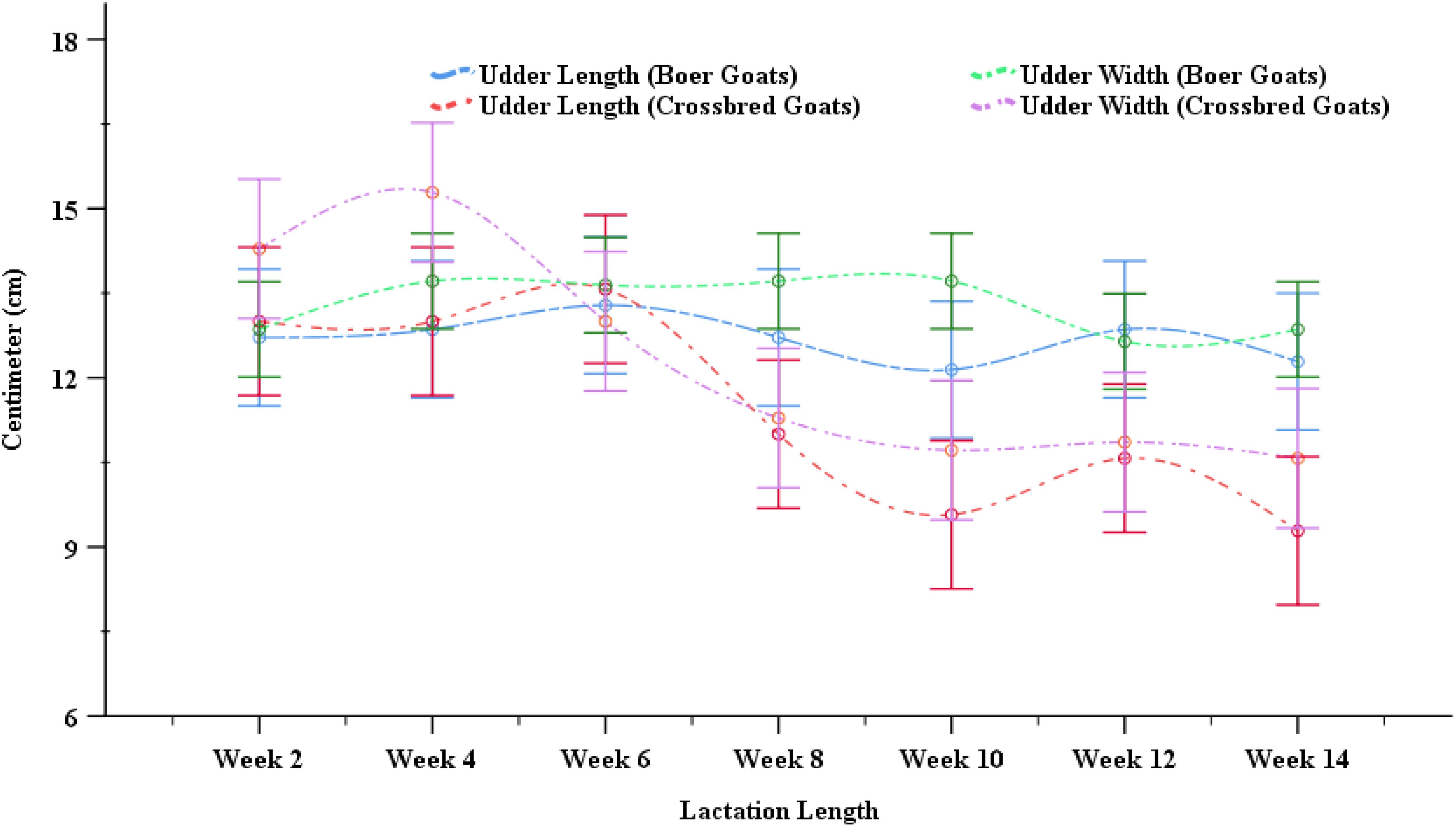
Figure 5. Changes in udder length (cm) and udder width (cm) across lactation stages in Boer goats and their crosses at the Sheep and Goat Farm of Hawassa University, Ethiopia.
The trends of udder circumference and teat angle in Boer and crossbred goats during the lactation period are given in Figure 6. The effect of the stage of lactation was significant (p<0.001) for udder circumference and teat angle. Udder circumference reaches its maximum at week 4 for both breeds, Boer goats had a significantly narrower udder circumference (40.86 cm) compared to crossbred goats (47.00 cm) at peak lactation. Udder circumference then gradually decreases in Boer goats over time, while crossbred goats show a sharper decline.
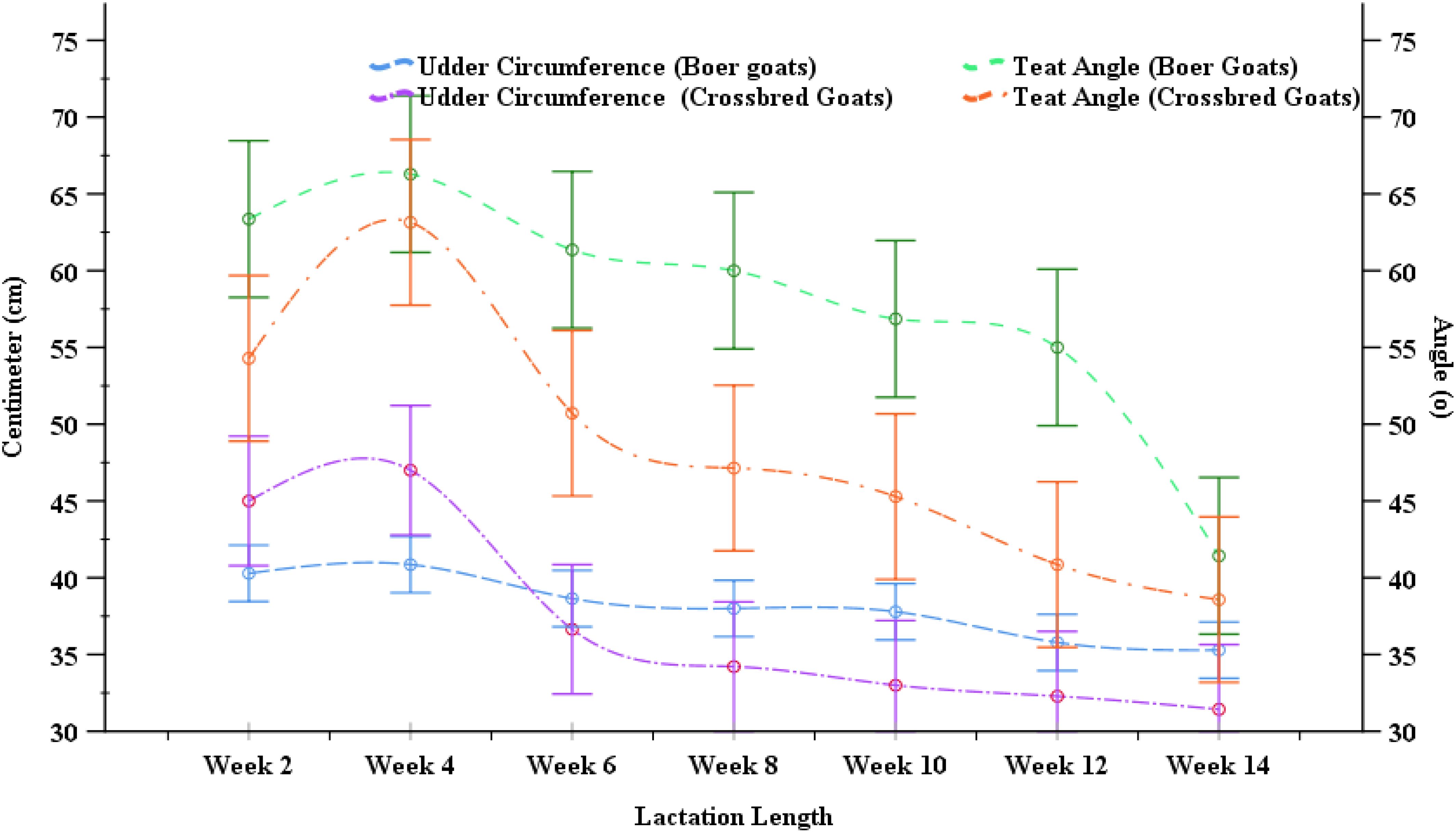
Figure 6. Changes in udder circumference (cm) and teat angle (degrees) across lactation stages in Boer goats and their crosses at the Sheep and Goat Farm of Hawassa University, Ethiopia.
Boer goats consistently had a longer udder length compared to crossbred goats throughout the lactation period except during the peak lactation. Teat angle increases significantly from the start of lactation, peaking around week 4. Boer goats exhibited larger teat angles (66.29°) compared to crossbred goats (63.14°).
The trends of teat circumference, length and diameter in Boer and crossbred goats during the lactation period are given in Figure 7. The effect of stage of lactation was significant (p<0.001) for teat circumference, length and diameter. Teat circumference increased significantly from the start of lactation, peaking around week 4, and then decreases gradually as lactation progresses. Boer goats consistently exhibited larger teat circumference (8.57 cm) compared to crossbred goats (8.00 cm) at peak. Teat length shows a similar pattern, with Boer goats reaching a maximum of 4.00 cm at peak lactation, while crossbred goats peaked at 4.00 cm and then a slight decrease in teat length after week 4. The figure shows that teat diameter in both breeds remained relatively similar patterns across the lactation stage.
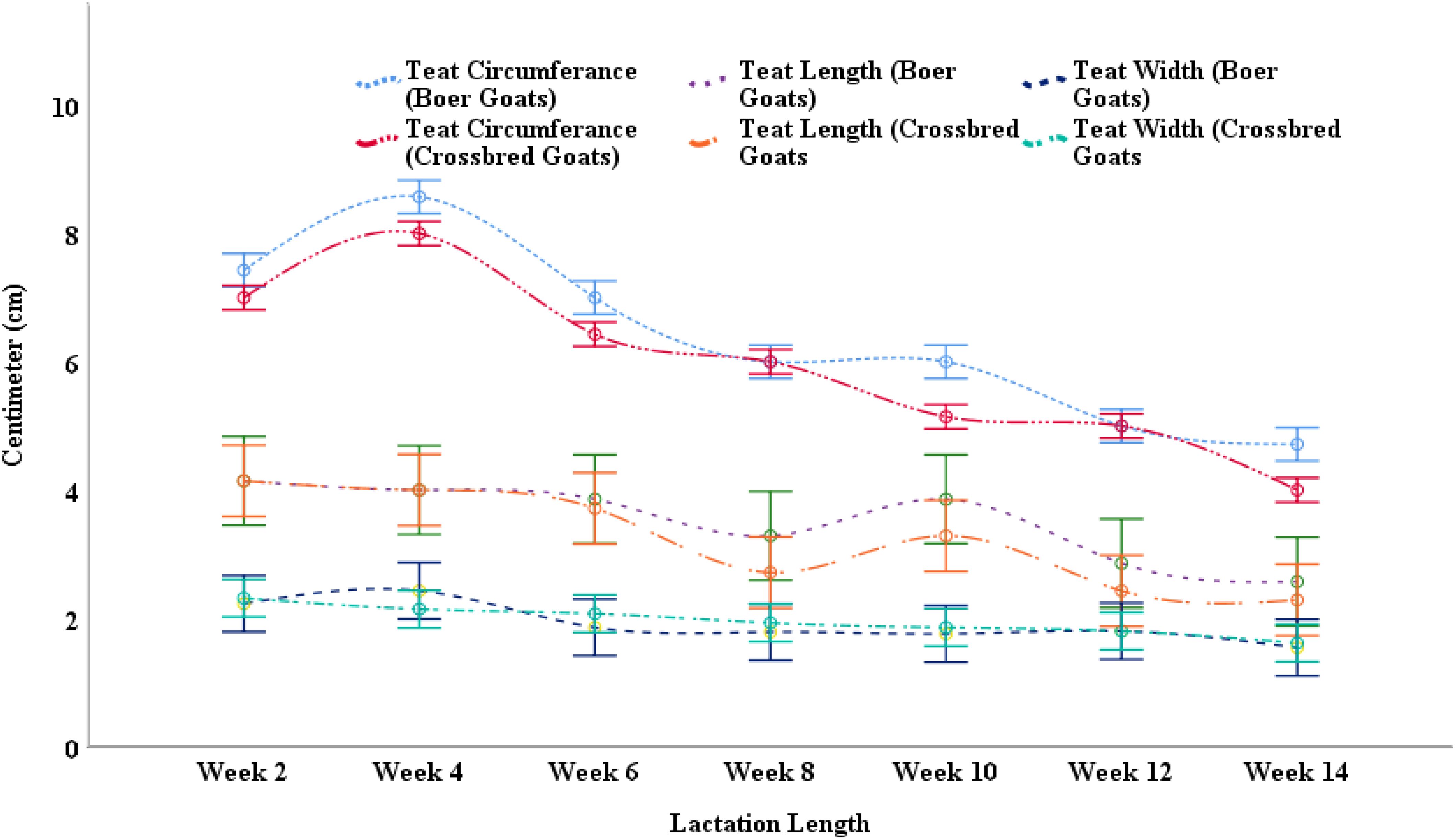
Figure 7. Changes in teat circumference (cm), teat length (cm), and teat diameter (cm) across lactation stages in Boer goats and their crosses at the Sheep and Goat Farm of Hawassa University, Ethiopia.
3.5 Correlation between milk yield and milk composition
The correlation coefficients showing the relationship between milk yield and composition traits presented in Table 3. Negative correlations were found between milk yield and fat content in both Boer goats (r = -0.39) and crossbred goats (r = -0.45). No significant correlations were observed between milk yield and protein, total solids, or solid not fat content in either breed.

Table 3. Correlation coefficients between milk yield (kg/day), total solids (%), fat (%), protein (%), solid not fat (%), and ash (%) for Boer goats and their crosses at the Sheep and Goat Farm of Hawassa University, Ethiopia.
3.6 Correlation between milk yield and udder morphometric traits
The correlations between milk yield and various udder morphological traits in both breeds are presented in Table 4. Pearson correlation analysis revealed significantly positive correlations between morphometric traits and milk yield. Udder circumference (r = 0.66, p < 0.01), udder width (r = 0.31), teat angle (r = 0.44), teat circumference (r = 0.80), teat length (r= 0.51), and teat diameter (r= 0.45) showed the highest correlation with milk yield in Boer goats. Similar correlations were found for crossbred goats, with milk yield significantly correlated with udder length (r = 0.50), udder circumference (r = 0.71), udder width (r = 0.55), teat angle (r = 0.54), teat circumference (r = 0.78), teat length (r= 0.50), and teat diameter (r= 0.28).
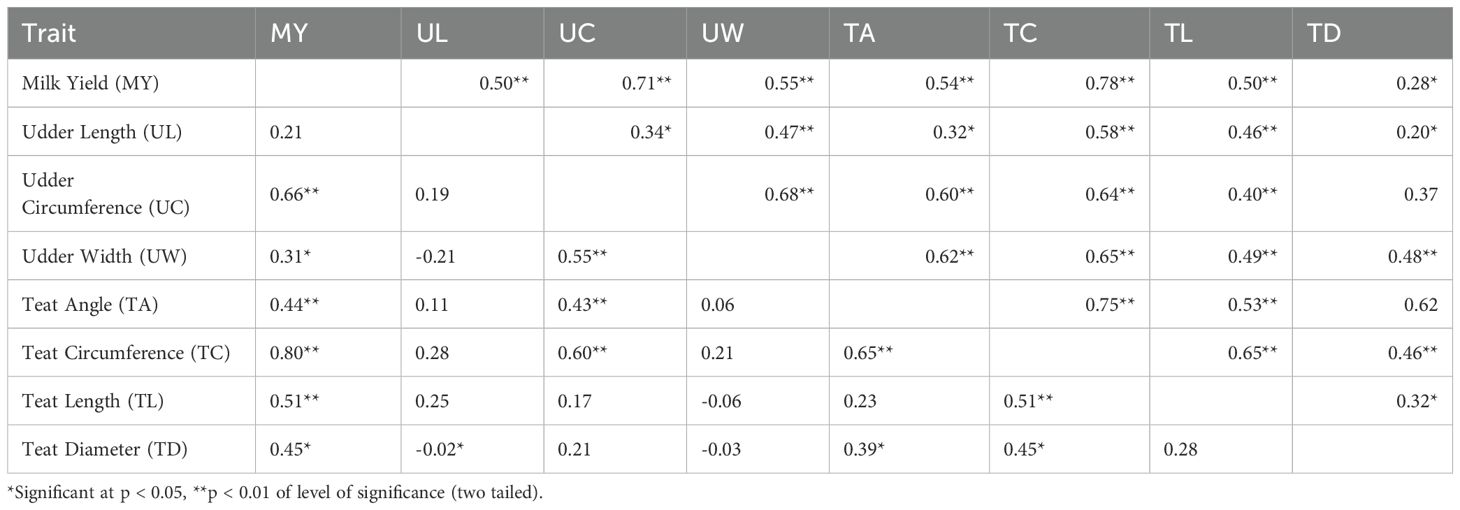
Table 4. Correlation coefficients between milk yield and udder length (cm), udder circumference (cm), udder width (cm), teat angle (°), teat circumference (cm), teat length (cm), and teat diameter (cm) for Boer goats (below diagonal) and their crosses (above diagonal) at the Sheep and Goat of Hawassa University, Ethiopia.
3.7 Regression analysis for milk yield prediction
Table 5 presents the stepwise regression analysis to predict milk yield based on udder morphological traits for both breeds. Stepwise regression analysis identified udder circumference as the most significant predictor of milk yield, explaining 67.5% of the variation, when combined with teat circumference, the predictive power increased to 72.6% of the variation in Boer goat. Similarly, for crossbred goats, udder circumference alone accounted for 59.7%, which increased to 69.1% of the variation in milk yield when teat circumference was included in the model. The high R² values suggest a strong predictive relationship, underscoring the importance of these traits to be used in assessing potential milk yield.
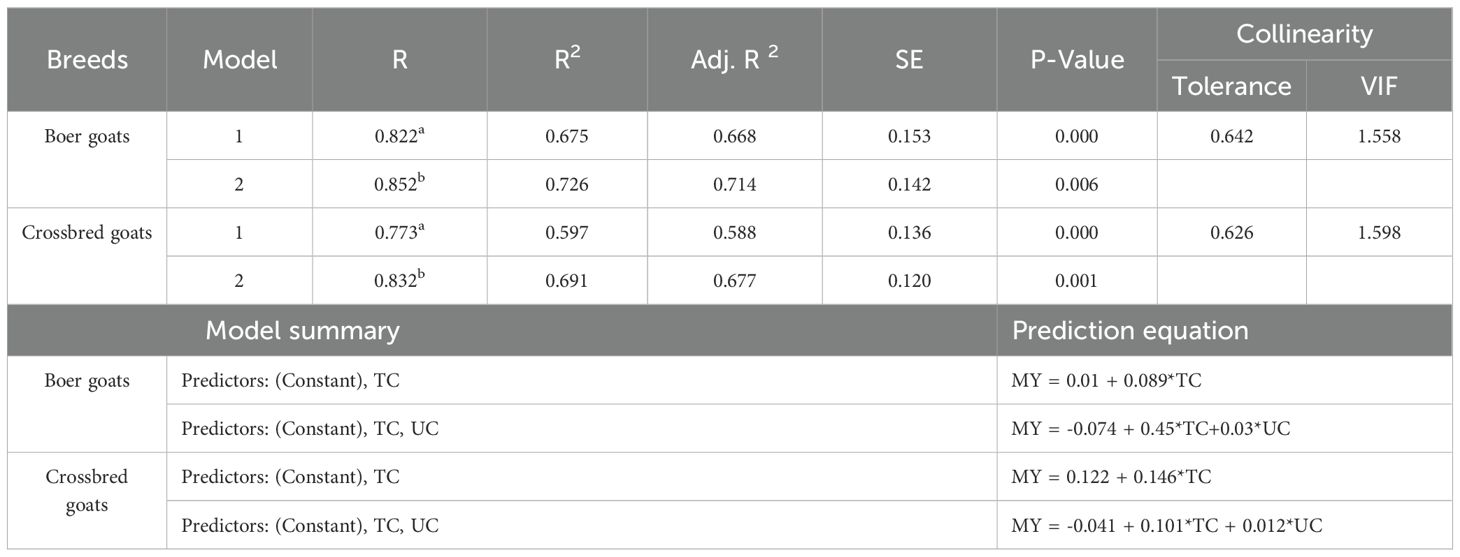
Table 5. Stepwise multiple linear regression equations for the prediction of milk yield using udder circumference (UC) and teat circumference (TC) in Boer goats and their crosses at the Sheep and Goat Farm of Hawassa University, Ethiopia.
4 Discussion
4.1 Milk yield and lactation patterns
The significantly higher milk yield observed in Boer goats (1.22 ± 0.05 kg/day) is consistent with previous findings (1.41 ± 0.09 kg/day), highlighting their better lactational performance under comparable management conditions (Mestawet et al., 2012; Mustefa et al., 2019). This suggests that Boer goats adapt well to Ethiopian production systems. The slight discrepancy in milk yield between studies may be attributed to seasonal influence, which are known to impact goats milk production (Bedhane et al., 2012). Our results also indicate a significant difference in milk yield between Boer goats (1.22 ± 0.05 kg/day) and crossbred goats (1.01 ± 0.05 kg/day), aligning with existing literature that underscores the better lactational performance of Boer goats under semi-intensive management conditions (Erasmus, 2000; Greyling et al., 2004). While crossbred goats show improved milk yield compare to previously reported 208.72 grams/day for indigenous Arsi-Bale goats (Bedhane et al., 2012). This improvement is likely a benefit from heterosis and environmental influence.
A significant effect of lactation stage was observed in both breeds (p < 0.05). The peak production during the third week of lactation, followed by a gradual decline, aligns with typical lactation curves reported for dairy goats (Zhu et al., 2020). However, Boer goats exhibited a sustained higher milk production over a prolonged period, indicating their potential to provide additional milk beyond the typical weaning period, which occurs at or before 90 days of age. Conversely, the steeper decline in milk yield observed in crossbred goats suggests a shorter lactation period.
4.2 Milk composition and lactation patterns
Boer goats exhibited significantly higher total solids, fat, and protein content compared to crossbred goats, reflecting breed-specific genetic and metabolic influence. The observed fat (4.64%) and protein (4.06%) levels in Boer milk align with prior reports (Erasmus, 2000; Mestawet et al., 2012; Akshit et al., 2024), demonstrating their potential to support optimal kid growth. Conversely, crossbred goats showed lower fat and protein values, highlighting the benefits of Boer crossbreeding for milk quality enhancement (Tegegne and Feye, 2020).
Total solid content was significantly higher in Boer goats (15.19%) compared to crossbred goats (12.84%), with value comparable to previous Ethiopian studies but lower than those reported for some other breeds (Mestawet et al., 2012). The lactation stage also significantly influenced total solids, which reached their lowest point at week 4 before progressively increasing. This pattern aligns with the well-documented concentration effects observed during later lactation stages (Ceballos et al., 2009).
The higher fat content observed in Boer (4.64%) and crossbred goats milk (4.31%), compared to Czech White Shorthaired goats (3.13%), and Turkish Saanen goats (3.62–3.86%) (Dračková et al., 2008; Konyali et al., 2010), likely reflects inherent breed differences. This variation also may be attributed to the Boer goat’s selection for meat traits, which are associated with enhanced lipid metabolism. Additionally, nutritional factors, particularly energy-dense diets, could further elevate fat levels may further contribute to increased fat deposition and nutritional factors, such as energy-dense diets. However, the lower fat content observed in this study compared to Granadina goats (5.23%) (Ceballos et al., 2009) suggests the influence of environmental or management effects. The typical lactation pattern, where fat content is lowest around week 4, coincides with peak milk production, and gradually increases as milk yield declines, was observed. This inverse relationship between milk yield and fat content is well-established (Park et al., 2007; Zhu et al., 2020). Improving fat content in crossbred goats would enhance the economic value of their milk, especially in regions where milk fat is a critical factor in dairy pricing (Akshit et al., 2024).
Protein content observed in Boer goats (4.06%) in the current study was consistent with the previous reports for Boer goats (4.05%) under similar production system (Mestawet et al., 2012), but higher than values reported for Alpine (3.87%) and Granadina goats (3.48) (Ceballos et al., 2009), Soryal et al., 2005). This difference possibly due to breed-specific selection for growth traits. The exceptionally high protein content in Sahelian goats (5.56%) (Ibeawuchi et al., 2003), may reflect arid-adaptation strategies. The parallel temporal trend observed for protein and fat content both decline until week 4 and subsequently increasing suggests shared regulatory mechanisms during lactation (Zhu et al., 2020). Selective breeding efforts in crossbred goats should focus on enhancing protein content to improve the nutritional value in smallholder farmer (Tesema et al., 2022).
The solid not fat content observed in Boer goats (10.61%) was intermediate between values that reported for Creole (9.55%) and Kalahari Red goats (11.27%) (Adewumi et al., 2017; Peña-Avelino et al., 2023). This variation likely reflects breed-specific differences in milk composition, potentially associated with breed adaptation to different production environments. The characteristic lactation pattern, featuring an initial decline until week four followed by a gradual increase through the remaining lactation period was observed. Similar trends have been reported in dairy goats, where solid not fat concentration rises as milk yield declines, resulting in more nutrient-dense milk during later lactation stages (Mayer and Fiechter, 2012). The relatively higher solid not fat content in Boer goats supports their suitability for producing concentrated dairy products such as milk powder. Enhancing solid not fat content in crossbred goats through selective breeding could improve their milk’s value for consumption in smallholder farmers and processing industries (Tafes, 2020).
Ash content remained stable at 0.05% for both breeds, which was lower than the 0.54% reported for Kalahari Red goats (Adewumi et al., 2017). The consistent mineral levels observed across lactation stages suggest homeostatic regulation of milk mineral composition. While this stability is advantageous for product standardization, targeted nutritional interventions could optimize mineral content to address specific dietary needs in regions with prevalent micronutrient deficiencies (Bhagat and Singh, 2022). Such improvements would enhance both the nutritional value and processing characteristics of goat milk products.
4.3 Correlation between milk yield and milk composition
Correlation analyses revealed significant inverse relationships between milk yield and fat content in both Boer (r = -0.39, p < 0.01) and crossbred (r = -0.45) goats. These findings confirm the well-documented inverse relationship between milk production and fat concentration, which is primarily attributed to dilution effects during peak lactation (Park et al., 2007; Zhu et al., 2020). Conversely, milk yield showed no significant correlations with protein and solid not fat content in either breed (p < 0.05). This stability of protein levels, even with yield fluctuations, supports prior research in goats (Mayer and Fiechter, 2012; Akshit et al., 2024). Additionally, weak negative correlations observed between milk yield and total solids (Boer goats: r = -0.14; Crossbred goats: r = -0.34), suggest a limited influence of yield on overall solid composition, consistent with previous studies (Mestawet et al., 2012). These findings highlight the breed-independent trade-off between milk yield and fat content, while also establishing the relative stability of other milk components.
4.4 Udder morphology and lactation patterns
The udder and teat morphometric measurements revealed significant breed-related differences, with Boer goats exhibiting better udder dimensions compared to crossbred goats. This aligns with established findings that udder traits are strongly influenced by genetic factors (Zahraddeen et al., 2008; Senthilkumar et al., 2019; Akbaş et al., 2021; Muhammad et al., 2021). The larger udder size in Boer goats (length: 12.69 cm; circumference: 38.09 cm; width: 13.31 cm) likely reflects their genetic predisposition for greater milk storage capacity and production efficiency (Iniguez et al., 2009; Elmaz et al., 2018).
The udder length in our study (Boer goats: 12.69 cm; crossbred goats: 11.43 cm) exceeded values reported by Muhammad et al (Muhammad et al., 2021), for Boer goats (11.25 cm) but was lower than measurements from indigenous breeds [14.43 cm; (Senthilkumar et al., 2019)]. These variations likely reflect differences in genetic potential, lactation stage, and environmental conditions (Merkhan and Alkass, 2011; Akbaş et al., 2021). Boer goats showed particularly advantageous udder circumference (38.09 cm) and width (13.31 cm) compared to other breeds, including Sahel goats [33.76 cm; (Zahraddeen et al., 2008)], Meriz goats (36.65 cm (Merkhan and Alkass, 2011);), and West African dwarf goats [10.27 cm; (Abu et al., 2013)], suggesting greater milk storage capacity and production efficiency (Iniguez et al., 2009; Akbaş et al., 2021).
Teat morphology followed similar patterns, with Boer goats displaying optimal characteristics for dairy production. Their teat length (3.51 cm) was intermediate between smaller Red Sokoto [2.27 cm; (Zahraddeen et al., 2008)] and larger White Short-haired goats [5.14 cm; (Merkhan and Alkass, 2011)], while teat circumference (6.39 cm) was comparable to Red Sokoto goats [6.58 cm; (Zahraddeen et al., 2008)]. The teat angle (57.76°) and diameter (1.96 cm) were particularly favorable, being similar to values reported for productive dairy breeds (Raphel et al., 2017; Akbaş et al., 2021). These traits collectively contribute to improved milk let-down and milking efficiency (Youssef et al., 2014), which are especially valuable for smallholder dairy operations where manual milking predominates (Eyduran et al., 2013).
Boer goats maintained peak udder dimensions longer (week 6) than crossbred goats (week 4), suggesting better lactation persistency, a valuable trait for sustained milk production (Kouri et al., 2019). The observed lactation patterns in udder morphology followed consistent trends across breeds, with all dimensions peaking around weeks 4–6 before gradual decline. This temporal pattern correlates strongly with milk yield dynamics, supporting the use of udder measurements as reliable indicators of production potential (Raphel et al., 2017). Particularly noteworthy was the more stable udder circumference and width in Boer goats throughout lactation, which may explain their better production performance compared to crossbred goats. Selection for stable udder and teat traits across lactation, including optimal teat angles, is crucial for improving milk production and udder health, especially in smallholder farmer (Eyduran et al., 2013; Youssef et al., 2014; Raphel et al., 2017).
The observed morphological differences have important implications for breeding programs. Boer goats’ intermediate values between specialized dairy and meat breeds suggest balanced genetic selection (Senthilkumar et al., 2019), while comparisons with high-producing dairy breeds highlight opportunities for targeted improvement. The stable maintenance of these optimal udder and teat characteristics throughout lactation underscores their value as selection criteria (Kouri et al., 2019). For smallholder systems, particular emphasis should be placed on teat angle and diameter, which significantly affect milking efficiency and udder health. These findings provide concrete morphological targets for genetic improvement programs aimed at enhancing both milk production efficiency and animal welfare.
4.5 Correlation between milk yield and udder morphology
Significant positive correlations between udder morphometric traits and milk yield were observed, highlighting the influence of udder characteristics on milk production efficiency. In Boer goats, udder circumference (r = 0.66) and teat circumference (r = 0.80) strongly correlated with milk yield, suggesting larger udder dimensions provide greater milk storage capacity, while optimal teat characteristics facilitate efficient milk extraction. The findings align with previous studies indicating that udder and teat traits significantly influence milking ease and productivity (Zahraddeen et al., 2008; Iniguez et al., 2009; Youssef et al., 2014). In crossbred goats, the slightly lower correlation coefficients suggest greater variability in udder traits, which may be attributed to genetic diversity introduced through crossbreeding. Teat length (r = 0.51) also contributed to milk yield, particularly relevant in manual milking systems (Eyduran et al., 2013; Muhammad et al., 2021). In crossbred goats, udder length (r = 0.50) and width (r = 0.55) correlated positively with milk yield, indicating larger udder dimensions support higher volumes, especially in breeds with lower yields (Tesema et al., 2022). Additionally, teat angle in Boer goats (r = 0.441) influenced milk yield, likely by improving udder health and milking efficiency (Raphel et al., 2017). These correlations emphasize the importance of udder morphology in optimizing dairy goat productivity.
4.6 Predictive power of udder morphometric traits for milk yield
Regression analysis revealed udder circumference and teat circumference as the significant predictors of milk yield, explain 72.6% and 69.1%, of variation in Boer and crossbred goats respectively. These breed-specific coefficients reflect inherent genetic variation in mammary development. Thus, udder measurements serve as criteria proxy trait for estimating milk production that can be used for screening breeds for milk yield (Iniguez et al., 2009; Elmaz et al., 2018).
Udder and teat circumferences are identified as robust, field-measurable predictors of milk yield, with high R2 values demonstrating their utility in Boer and crossbred goats, consistent with prior researches (Fernandez et al., 1995; Arcos-Álvarez et al., 2020; Vrdoljak et al., 2020; Makamu et al., 2023). Udder circumference facilitates efficient selection for enhanced milk production without complex testing, while teat circumference significantly impacts milk extraction efficiency, particularly in manual milking systems prevalent in regions like Ethiopia. Prioritizing these traits in breeding programs offers a targeted approach to improving dairy goat.
4.7 Recommendations for future research
The crossbreeding of Boer goats with indigenous goats is currently underway in various regions of Ethiopia. It is recommended that similar studies with larger sample sizes be initiated to validate the current study’s relevance. Additionally, it is advisable to investigate the milk yield and composition of Boer goats over an extended lactation period, such as five months postpartum, to obtain a comprehensive understanding of lactation yield. Finally, including the measurement of udder traits in breed characterization work is recommended for estimating milk production potential under field conditions.
5 Conclusion
This study evaluated milk production, composition, and udder morphometric traits in Boer goats and their crosses under Ethiopian conditions. The results demonstrated that Boer goats outperformed crossbred goats in both milk yield and composition, exhibited higher total solids, fat, and protein content. Additionally, Boer goats displayed larger udder dimensions and more favorable teat morphometry, indicating better milk storage and extraction capability. The lactation curve peaked during the third week, aligning with typical dairy goat lactation patterns. A significant inverse relationship between milk yield and fat percentage further corroborated the well establish trade-off between these traits. Notably, Udder and teat circumference emerged as strong predictors of milk yield in Boer and crossbred goats. These findings highlight their potential as practical selection criteria for breeding programs.
Data availability statement
The raw data supporting the conclusions of this article will be made available by the authors, without undue reservation.
Ethics statement
Ethical approval was not required for the studies involving animals in accordance with the local legislation and institutional requirements because Ethiopia does not currently have a dedicated ethics committee specifically for reviewing animal experiments. However, this study strictly adhered to the highest ethical standards. All procedures involving animals were conducted with the utmost care, prioritizing their welfare and ensuring their well-being at every stage. The animals were managed under standard care protocols under routine practices, with close attention to minimizing stress and maintaining optimal living conditions throughout the study. The research was conducted in full compliance with recognized ethical guidelines. Written informed consent from the owners of the animals was not obtained because the animals used in this study were housed at the Sheep and Goat Crossbreeding and Multiplication Center of Hawassa University, which is a research facility managed by the university. As a student conducting research at this facility, the animals were under institutional care and management, following standard protocols for research purposes. Since the university owns and oversees the care of these animals, obtaining consent from external owners was not applicable in this case.
Author contributions
RB: Conceptualization, Data curation, Formal analysis, Funding acquisition, Investigation, Methodology, Project administration, Resources, Software, Supervision, Validation, Visualization, Writing – original draft, Writing – review & editing. GA: Conceptualization, Data curation, Formal analysis, Funding acquisition, Investigation, Methodology, Project administration, Resources, Software, Supervision, Validation, Visualization, Writing – original draft, Writing – review & editing. SB: Conceptualization, Data curation, Formal analysis, Funding acquisition, Investigation, Methodology, Project administration, Resources, Software, Supervision, Validation, Visualization, Writing – original draft, Writing – review & editing.
Funding
The author(s) declare that no financial support was received for the research and/or publication of this article.
Conflict of interest
The authors declare that the research was conducted in the absence of any commercial or financial relationships that could be construed as a potential conflict of interest.
Generative AI statement
The author(s) declare that no Generative AI was used in the creation of this manuscript.
Publisher’s note
All claims expressed in this article are solely those of the authors and do not necessarily represent those of their affiliated organizations, or those of the publisher, the editors and the reviewers. Any product that may be evaluated in this article, or claim that may be made by its manufacturer, is not guaranteed or endorsed by the publisher.
References
Abu A. H., Mhomga L. I., and Akogwu E. I. (2013). Assessment of udder characteristics of West African Dwarf (WAD) goats reared under different management systems in Makurdi, Benue State, Nigeria. Afr. J. Agric. Res. 8, 3255–3258. doi: 10.5897/AJAR2013.7132
Adewumi O. O., Oluwatosin B. O., Tona G. O., Williams T. J., and Olajide O. O. (2017). Milk yield and milk composition of Kalahari Red goat and the performance of their kids in the humid zone. Arch. Zootec 66, 587–592. doi: 10.21071/az.v66i256.2776
AE M. M. (2022). Rumen parameters, nutrients digestibility and milk production of lactating boer goats fed diets containing clay minerals. Pak. J. Biol. Sci. 25, 755–764. doi: 10.3923/pjbs.2022.755.764
Akbaş A. A., Taşçı F., Elmaz, and Saatcı M. (2021). Evaluation of milk yield and milk composition of honamlı Goats. J. Hell Vet. Med. Soc 72, 2747–2754. doi: 10.12681/jhvms.26760
Akshit F. N. U., Mao T., Kaushik R., Poswal V., and Deshwal G. K. (2024). Global comprehensive review and meta-analysis of goat milk composition by location, publication year and lactation stage. J. Food Compos Anal. 127, 105973. doi: 10.1016/j.jfca.2024.105973
ALKaisy Q. H., Al-Saadi J. S., Al-Rikabi A. K. J., Altemimi A. B., Hesarinejad M. A., and Abedelmaksoud T. G. (2023). Exploring the health benefits and functional properties of goat milk proteins. Food Sci. Nutr. 11, 5641–5656. doi: 10.1002/fsn3.v11.10
Arcos-Álvarez D., Canul-Solís J., García-Herrera R., Sarmiento-Franco L., Piñeiro-Vazquez Á., Casanova-Lugo F., et al. (2020). Udder measurements and their relationship with milk yield in Pelibuey ewes. Animals 10, 518. doi: 10.3390/ani10030518
Barlowska J., Pastuszka R., Krol J., Brodziak A., Teter A., and Litwinczuk Z. (2020). Differences in physico-chemical parameters of goat milk depending on breed type, physiological and environmental factors. Turkish J. Vet. Anim Sci. 44, 720–728. doi: 10.3906/vet-1912-102
Bedhane M., Haile A., Dadi H., and Alemu T. (2012). Estimates of genetic and phenotypic parameters for milk traits in Arsi-Bale goat in Ethiopia. Livest Res. Rural Dev. 24, 2012.
Bhagat S. and Singh S. (2022). Nanominerals in nutrition: Recent developments, present burning issues and future perspectives. Food Res. Int. 160, 111703. doi: 10.1016/j.foodres.2022.111703
Ceballos L. S., Morales E. R., de la Torre Adarve G., Castro J. D., Martínez L. P., and Sampelayo M. R. S. (2009). Composition of goat and cow milk produced under similar conditions and analyzed by identical methodology. J. Food Compos Anal. 22, 322–329. doi: 10.1016/j.jfca.2008.10.020
Devani K. (2021). Genetic and economic implications of teat and udder structure in Canadian Angus cattle. (Doctoral thesis), University of Calgary, Calgary, Canada. Available online at: https://prism.ucalgary.ca.
Dračková M., Hadra L., Janštová B., Navrátilová P., Přidalová H., and Vorlová L. (2008). Analysis of goat milk by near-infrared spectroscopy. Acta Vet. Brno 77, 415–422. doi: 10.2754/avb200877030415
Elmaz Ö., Tasçı F., Akbaş A. A., and Saatci M. (2018). First lactation milk yield, composition, and some udder measurements of Honamli goats raised under extensive conditions. Anim. Sci. Pap. Rep. 36 (4), 393–403.
Erasmus J. A. (2000). Adaptation to various environments and resistance to disease of the Improved Boer goat. Small Rumin Res. 36, 179–187. doi: 10.1016/S0921-4488(99)00162-5
Eyduran E., Yilmaz I., Kaygisiz A., and Aktas Z. M. (2013). An investigation on relationship between lactation milk yield, somatic cell count and udder traits in first lactation Turkish Saanen Goat using different statistical techniques. J. Anim. Plant Sci. 23 (4), 956–963.
Fernandez G., Alvarez P., San Primitivo F., and de la Fuente L. F. (1995). Factors affecting variation of udder traits of dairy ewes. J. Dairy Sci. 78, 842–849. doi: 10.3168/jds.S0022-0302(95)76696-6
Greyling J. P. C., Mmbengwa V. M., Schwalbach L. M. J., and Muller T. (2004). Comparative milk production potential of Indigenous and Boer goats under two feeding systems in South Africa. Small Rumin Res. 55, 97–105. doi: 10.1016/j.smallrumres.2003.11.014
Habtegiorgis K., Legesse D., and Bikamo M. (2024). Assessing the impact of boer goat x indigenous goat crossbreeding on reproductive performance and farmer perceptions in southern Ethiopia. Sci. World J. 2024, 6637667. doi: 10.1155/2024/6637667
Ibeawuchi J. A., Ahamefule F. O., and Ringim I. A. (2003). The influence of lactation stage on the milk constituents of Sahelian goats. Niger J. Anim Prod. 30, 259–264. doi: 10.51791/njap.v30i2.1518
Idamokoro E. M., Muchenje V., and Masika P. J. (2017). Yield and milk composition at different stages of lactation from a small herd of Nguni, Boer, and non-descript goats raised in an extensive production system. Sustainability 9, 1000. doi: 10.3390/su9061000
Iniguez L., Hilali M., Thomas D. L., and Jesry G. (2009). Udder measurements and milk production in two Awassi sheep genotypes and their crosses. J. Dairy Sci. 92, 4613–4620. doi: 10.3168/jds.2008-1950
James I. J., Osinowo O. A., and Adegbasa O. I. (2009). Evaluation of udder traits of west african dwarf (wad) goats and sheep in Ogun state, Nigeria. J. Agric. Sci. Environ. 9, 75–87.
Konyali A., Ayag B. S., and Yurdabak S. (2010). Effect of estrus synchronization on dairy goat milk composition. Afr. J. Agric. Res. 5, 681–684.
Kouri F., Charallah S., Kouri A., Amirat Z., and Khammar F. (2019). Milk production and its relationship with milk composition, body and udder morphological traits in Bedouin goat reared under arid conditions. Acta Sci. Anim Sci. 41, e42552. doi: 10.4025/actascianimsci.v41i1.42552
Kuraz Abebe B. (2022). A review of the potential and constraints for crossbreeding as a basis for goat production by smallholder farmers in Ethiopia. Bull. Natl. Res. Cent 46, 80. doi: 10.1186/s42269-022-00763-7
Leggesse G., Gelmesa U., Jembere T., Degefa T., Bediye S., Teka T., et al. (2023). Ethiopia national dairy development strategy 2022–2031. (Addis Ababa, Ethiopia: Ministry of Agriculture, Federal Democratic Republic of Ethiopia). Available online at: https://hdl.handle.net/10568/135703.
Lu C. D. (2001). “Boer goat production: Progress and perspective,” in Proceedings of the 2001 International Conference on Boer Goats in China (Citeseer, Guizhou, China).
Makamu T. C., Madikadike M. K., Mokoena K., and Tyasi T. L. (2023). Relationship between body measurement traits, udder measurement traits and milk yield of Saanen goats in Capricorn district of South Africa. Rev. Mex Cienc. Pecu 14, 423–433. doi: 10.22319/rmcp.v14i2.6190
Marie-Etancelin C., Astruc J.-M., Porte D., Larroque H., and Robert-Granié C. (2005). Multiple-trait genetic parameters and genetic evaluation of udder-type traits in Lacaune dairy ewes. Livest Prod. Sci. 97, 211–218. doi: 10.1016/j.livprodsci.2005.04.005
Mayer H. K. and Fiechter G. (2012). Physical and chemical characteristics of sheep and goat milk in Austria. Int. Dairy J. 24, 57–63. doi: 10.1016/j.idairyj.2011.10.012
Merkhan K. Y. and Alkass J. E. (2011). Influence of udder and teat size on milk yield in Black and Meriz goats. Res. Opin. Anim Vet. Sci. 1, 601–605.
Mestawet T. A., Girma A., Ådnøy T., Devold T. G., Narvhus J. A., and Vegarud G. E. (2012). Milk production, composition and variation at different lactation stages of four goat breeds in Ethiopia. Small Rumin Res. 105, 176–181. doi: 10.1016/j.smallrumres.2011.11.014
Muhammad H. A., Garba Y., Ogah D., and Inusa S. K. (2021). Effect of milking time, lactation stage and udder traits on milk yield of Red Sokoto and Boer goats in semi-arid, Nigeria. Niger J. Anim Prod. 48, 100–112. doi: 10.51791/njap.v48i5.3190
Mustefa A., Banerjee S., Gizaw S., Taye M., Getachew T., Areaya A., et al. (2019). Reproduction and survival analysis of Boer and their crosses with Central Highland goats in Ethiopia. Development 31, 10.
Navamniraj K. N., Sivasabari K., Indu J. A., Krishnan D., Anjali M. R., Akhil P. R., et al. (2023). Beneficial impacts of goat milk on the nutritional status and general well-being of human beings: anecdotal evidence. J. Exp. Biol. Agric. Sci. 11 (1), 1–15. doi: 10.18006/2023.11(1).1.15
Park Y. W., Juárez M., Ramos M., and Haenlein G. F. W. (2007). Physico-chemical characteristics of goat and sheep milk. Small Rumin Res. 68, 88–113. doi: 10.1016/j.smallrumres.2006.09.013
Peña-Avelino L. Y., Ceballos-Olvera I., Rosales-Martinez G. N., Hernández-Melendez J., and Alva-Pérez J. (2023). Milk composition of creole goats raised at different altitudes in an extensive production system in Northeast Mexico. Animals 13, 1738. doi: 10.3390/ani13111738
Raphel J., Tizhe M. A., Shua J. N., and Kubkomawa H. I. (2017). International journal of animal research (ISSN: 2575-7822). J. Anim Res. 1, 12.
Senthilkumar S., Kannan T. A., Ramesh G., Sumathi D., and Gnanadev R. (2019). Gross morphometric findings of udder and teat in Boer local she-goats. Pharma Innov. J. 8, 301–303.
Soryal K., Beyene F. A., Zeng S., Bah B., and Tesfai K. (2005). Effect of goat breed and milk composition on yield, sensory quality, fatty acid concentration of soft cheese during lactation. Small Rumin Res. 58, 275–281. doi: 10.1016/j.smallrumres.2004.11.003
Tade B. and Melesse A. (2023). A review on differentiation of goat populations in Ethiopia based on husbandry practices, breeding and morphological traits: The primary step for conservation. Int. J. Livest Prod. 14, 13–21. doi: 10.5897/IJLP2022.0799
Tadesse Asfaw T. (2018). Dry and wet season supplementation on performance of short eared Somali goats raised under farmers grazing condition in Dire Dawa Administration, Ethiopia. (Doctoral dissertation). Haramaya university, Ethiopia.
Tafes A. G. (2020). Compositional and technological properties of goat milk and milk products a review. Concepts Dairy Vet. Sci. 3, 295–300.
Tegegne A. and Feye G. (2020). Study of selected livestock innovations in Ethiopia. zef Cent Dev. Res. Univ. Bonn Work Pap 192, 1–63. doi: 10.2139/ssrn.3653067
Tesema Z., Alemayehu K., Kebede D., Getachew T., Deribe B., Alebachew G. W., et al. (2022). Performance evaluation of boer× Central highland crossbred bucks and farmers’ Perceptions on crossbred goats in northeastern Ethiopia. Adv. Agric. 2022, 6998276. doi: 10.1155/2022/6998276
Vrdoljak J., Prpić Z., Samaržija D., Vnučec I., Konjačić M., and Kelava Ugarković N. (2020). Udder morphology, milk production and udder health in small ruminants. Mljekarstvo časopis za unaprjeđenje Proizv i prerade mlijeka 70, 75–84.
Youssef H. F. H., Saifelnasr E. O. H., El-Sanafawy H. A., and Saba F. E. (2014). Relationship between udder characteristics and each of reproductive performance and milk production and milk composition in Zaraibi and Damascus dairy goats. Egypt J. Sheep Goats Sci. 9, 1–10.
Zahraddeen D., Butswat I. S. R., and Mbap S. T. (2008). Udder and teat traits as possible selection markers for milk yield in local goats of Nigeria. Glob. J. Agric. Sci. 7, 23–26. doi: 10.4314/gjass.v7i1.2353
Zannou O., Sow A., Rekik M., Amole T. A., Doyle R., Hoek R. V.D., et al. (2024). Manual of integrated package for herd health, reproduction and feed management of small ruminants in Mali. (CGIAR Initiative on Sustainable Animal Productivity), 1–57.
Keywords: Boer goat, crossbred goat, milk yield, milk composition, udder traits
Citation: Bekele R, Abebe G and Banerjee S (2025) Milk production, composition, and udder morphometric traits across various lactation stages of Boer goats and their crosses in Ethiopia. Front. Anim. Sci. 6:1509079. doi: 10.3389/fanim.2025.1509079
Received: 10 October 2024; Accepted: 29 May 2025;
Published: 18 June 2025.
Edited by:
Juliana Petrini, Clinica do Leite Ltda, BrazilReviewed by:
Zeying Wang, Shenyang Agricultural University, ChinaEnrico Mancin, Natural Resources, Animals and the Environment, University of Padua, Italy
Natasha Jaques, Massey University, New Zealand
Copyright © 2025 Bekele, Abebe and Banerjee. This is an open-access article distributed under the terms of the Creative Commons Attribution License (CC BY). The use, distribution or reproduction in other forums is permitted, provided the original author(s) and the copyright owner(s) are credited and that the original publication in this journal is cited, in accordance with accepted academic practice. No use, distribution or reproduction is permitted which does not comply with these terms.
*Correspondence: Rekik Bekele, cmVraWtiZWtlbGVAZ21haWwuY29t
 Rekik Bekele
Rekik Bekele Girma Abebe2
Girma Abebe2 Sandip Banerjee
Sandip Banerjee